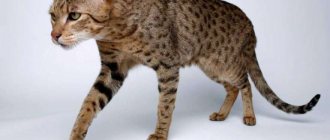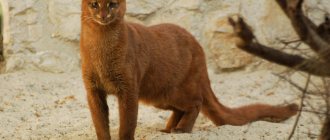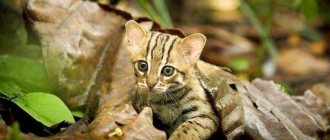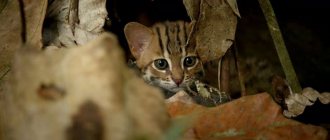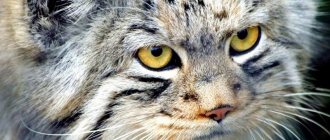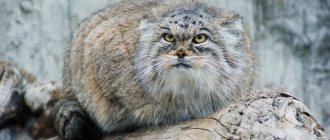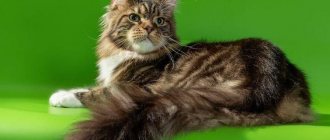Felines are a family of mammals belonging to the order Carnivora. Most often, they get their food by sneaking up and stalking it, sometimes by chasing it.
This family includes many animals, some of which, such as the Amur tiger, are impressive in size and weight. But there are also miniature animals whose weight does not exceed 1 kg.
The smallest wild cats in the world can live in different parts of the planet. But, unlike big cats, they give birth every year or more often, they can give birth to 5 to 6 cubs. This is the only thing that unites them, and their appearance, color, habits and lifestyle can differ significantly.
Each of them has its own unique character, although most eat rodents, are nocturnal and prefer solitude.
Jaguarundi
They are part of the Puma genus. They have an elongated body, particularly flexible, short but strong legs and a long, thin tail. In appearance, it is somewhat similar to a weasel. It is bright red or brown mixed with other shades.
The length of the jaguarundi is from 55 to 77 cm, plus a tail, which can grow up to 33-60 cm, height - from 25 to 35 cm. You can meet it in America. They live alone. They are terrestrial animals, especially active during the day, but they can climb trees.
They feed on small prey (up to 1 kg), everything they can catch. Sometimes they raid poultry houses, or eat green figs.
Natural enemies of oncilla
Photo: Oncilla cat
Oncilla is a fierce predator, despite its small size. Because of this, it does not have natural enemies that would conduct a targeted hunt for this cat. However, a number of animals can pose an unintended threat to the oncilla.
Some large monkey species may attack the oncilla in self-defense. Monkeys are not inferior in speed and agility to this cat, so they can seriously injure it or even kill it. However, oncilla are unlikely to attack large primates, although they sometimes attack prey that is much larger than them.
Large birds of prey can also be a threat to the oncilla. If a cat climbs too high in the trees, it will be easy for a bird of prey to snatch it from the branch. The oncilla weighs very little, so a harpy or some species of eagles can easily carry it in their paws. This is especially true for kittens.
Best articles: The strangest and most incredible facts about animals
Pythons and boa constrictors can pose a threat to oncillas, although they are quite slow. A cat easily notices a camouflaged boa constrictor by smell and catches the slightest sounds, so adults will not be caught by this predator. But a boa constrictor can strangle growing oncilli or destroy a nest with blind kittens. Likewise, smaller snakes may feed on newborn kittens while their mother is hunting.
forest cat
This small predator lives in Europe, as well as in Africa and Asia, which is also called the wild or European cat . He regularly hunts small animals and birds. Lives alone.
The forest cat is timid and tries to avoid people, often being aggressive. These animals have brown fur with black stripes. They have a thick tail. Body size is forty-five to eighty centimeters, height is thirty-five centimeters, while the length of the tail is thirty centimeters. They weigh from three to eight kilograms. African subspecies are much smaller in size.
Origin story
In the first epoch of the Cenozoic era, 60 million years ago, a family of terrestrial carnivorous predators formed on earth. From the family of mammals from the order of predators came the genus of felines Pseudoailurus, from which the subfamilies of cats originate: small, large and saber-toothed cats.
The forest cat comes from the subfamily of small cats. Ancient small predators lived in North America, Asia and Europe. Animals have taken root well on the American continent; the most exotic representative of felines is the American forest cat, the ocelot.
Forest cats are predators, the history of whose origin stretches back to centuries ago. In a variable climate, from periods of drought to abnormally low temperatures, wild cats have survived.
Having survived natural disasters, wild forest cats began to adapt to life in harsh, impassable places. Small forest predators have taken root well in forests, hence the name forest cat.
Felis silvestris is the Latin name for the subspecies, meaning wild cat. The forest wild cat is listed in the Red Book. Purebred extinction of wild forest cats occurs due to mating with homeless outbred felines.
Iriomotean cat
This is a subspecies of the Bengal cat that lived on the small island of Iriomote, located near Taiwan. For a long time, the Iriomotean cat was considered a separate species. It was discovered in 1965.
The length of a cat with a tail is from seventy to ninety cm, and it makes up about 25% of its length. It weighs from three to five kg. It is dark brown in color, with small dark spots, which then merge into stripes. The animal prefers a nocturnal lifestyle, and during the day it hides in secluded corners. Prefers a solitary life. It feeds on rodents, waterfowl and crabs.
Now the number of these animals is rapidly declining, because... The meat of the Iriomotey cat is considered a delicacy among the local population. There are now less than 100 individuals.
Diet
To identify the food preferences of this secretive and cautious predator, scientists had to examine the contents of animal stomachs and fecal matter. It turned out that the basis of Margay’s diet consists of:
- monkey;
- birds;
- lizards;
- reptiles;
- sloths;
- tree frogs;
- proteins;
- opossums;
- reed rats;
- packs Cuniculus paca – weighing 5-12 kg;
- porcupines;
- Guinea pigs;
- eggs from bird nests;
- insects;
- grass, fruits to improve the functioning of the gastrointestinal tract.
Analyzing the list of potential victims, it is easy to notice that although the animal prefers to hunt in trees, it also does it well on the ground.
When hunting at night and during the day, the predator prefers to take a wait-and-see position, attacking precisely at the moment when the prey does not expect it. The beast can pursue prey for a short time, but usually a lightning-fast throw is fatal.
The hunt usually begins at midnight and ends just before dawn. The Brazilian species are distinguished by the fact that they can pursue prey at any time of the day.
The average amount of food per day for an adult is about half a kilogram.
Manul
Otocolobus manul comes from Greek words that can be translated as “dwarf ear.” cat is also called Pallas's cat , after the man who first described it in 1776. It was a naturalist from Germany P.S. Pallas.
In size, it resembles an ordinary cat: length - from 52 to 65 cm, and tail - from 23 to 31 cm. Pallas's cat weighs two to five kg. He has a thick and long tail, sideburns on his cheeks, and small and round ears.
Among the cats, the Pallas's cat is the fluffiest. The fur is gray, the fibers have white tips, which makes it seem like it is dusted with snow. There are narrow stripes. It can be seen in Asia, in steppe or semi-desert areas of the mountains.
It is active at night or early in the morning; during the day it sleeps in a shelter: in rocks or in old burrows. Eats rodents and pikas, sometimes larger prey. Pallas cats do not know how to run fast; they hide from enemies by climbing rocks and stones. Their numbers are rapidly declining.
Life of an oncilla in captivity
Tiger cats feel quite comfortable in captivity; they can even be kept at home. Small kittens are easily tamed, domesticated and accustomed to humans. However, even a miniature jaguar born in captivity exhibits the character of a wild cat. The pet retains an obstinate disposition, has a habit of loneliness and is active mainly at night and twilight. Increased jumping ability can cause owners a lot of problems and troubles. A wild forest predator will never become tame and affectionate.
Oncilla can be found very rarely in zoos
Features of care
It is extremely difficult to keep oncilla in an apartment. If there are small children in the family, then having such an animal is strongly not recommended. A wild cat will constantly strive to be free, so all windows must be covered with a strong metal mesh or lattice. For such an exotic animal, a spacious enclosure is better suited, in which it is necessary to create conditions as close as possible to its natural habitat. The cage is equipped with tree trunks, ladders, stones, shelters and other attributes that allow the animal to feel at ease.
The oncilla enclosure should be spacious
The diet of wild cats should consist exclusively of raw meat (beef, veal, etc.), and it is preferable to give live food (mice, rats, rabbits, etc.). Special vitamin and mineral supplements are required. You only need to feed once a day. Sometimes fasting fasting days are arranged (according to the schedule). To keep your pet healthy and active, you need to take it to the vet regularly.
Oncillas reproduce successfully at the Sao Paulo Zoo
Wild cats are rarely fully domesticated. The habit of a free life and obstinate character remain with them forever. A random acquaintance has an ocelot at home, which was bought as a small kitten from a good nursery. While the cat was small, there were no problems with him. The pet slept in an embrace with his youngest daughter and did not get out of his arms. It should be noted that he quickly got used to the tray and went to it regularly. But when the cat grew up, he began to show wild habits. The furniture and wallpaper were torn to shreds; it was absolutely impossible to leave him alone at home. Even when playing and not showing any signs of aggression, he could seriously bite or scratch. As a result, the animal had to be moved into an enclosure, from where it is sometimes released for a walk. Organizing proper nutrition for such an animal is troublesome and very expensive.
Purchasing a kitten
You need to buy an oncilla kitten only in specialized nurseries, where they are raised using a special method. Small pets undergo careful selection and the necessary vaccinations, are registered and receive documents (veterinary passport, pedigree, etc.). It is almost impossible to buy small tiger cats in Russia; they are ordered from America.
You only need to buy a kitten from a special nursery.
Long-tailed cat
a long-tailed cat
lives in dense forests , which is also called margay . The length of its body is from sixty to eighty cm, plus a long tail (40 cm). It weighs from four to eight kg. She has a yellowish-brown coat that has dark ring-shaped spots on it.
Prefers solitude and emerges from its hiding place only at night. Eats rodents, birds, and small primates. This cat spends most of its life on branches. Long-tailed cats are now endangered. It is prohibited to catch or shoot them.
Oncilla
Oncilla
Beauty! An exact copy of a jaguar, only small. This is an eighty-centimeter animal with beautiful spotted fur, a cute face with round ears and big eyes. Oncilla lives in moist evergreen forests of Central and South America. It feeds on rodents, birds, snakes, frogs and small monkeys.
Beneath its pretty and very attractive appearance lies the wild and unbridled character of the oncilla. Animals are very aggressive and are not afraid to fight large predators, and often defeat them.
Oncillas are being exterminated for their beautiful fur, and their population is also declining due to human development of their habitats. Some people keep oncillus at home.
Kalimantan cat
Its other name is Borneo cat . She lives on the island of Kalimantan, which belongs to Malaysia and Indonesia. This is a rather rare and poorly studied species. The first whole animal was discovered in 1992, she fell into a trap. She was transported half-dead to the Sarawak State Museum.
It was only in 2002 that they were able to of a Kalimantan cat in the wild Her body length is 58 cm, she weighs from 2.3 to 4.5 kg.
Velvet cat
The velvet cat is one of the smallest: its body length is from 65 to 90 cm, but slightly less than half of this length (40%) is its tail. Its height is twenty-four to thirty cm, and it weighs from 2.1 to 3.4 kg; females are even smaller.
The velvet cat has thick fur, which can protect it from sub-zero temperatures. The color ranges from sand to gray, with brownish stripes on the back. Found in hot, dry areas: sandy deserts, rocky valleys.
They are especially active at night, and during the day they hide in abandoned burrows of other inhabitants of the area. They eat game, anyone they can catch. They may not drink for a long time.
Description
» data-layzr=»https://natworld.info/wp-content/uploads/2016/10/Dlinnohvostaya-koshka-v-Natsionalnom-parke-Korkovado-e1476120518164.jpg» alt=»dlinnohvostaya-koshka-v-natsionalnom -parke-korkovado" width="350″ height="233″ data-layzr-srcset="https://natworld.info/wp-content/uploads/2016/10/Dlinnohvostaya-koshka-v-Natsionalnom-parke- Korkovado-e1476120518164.jpg 350w, https://natworld.info/wp-content/uploads/2016/10/Dlinnohvostaya-koshka-v-Natsionalnom-parke-Korkovado-e1476120518164-300×200.jpg 300w" sizes="( max-width: 350px) 100vw, 350px" />
The margay is a beautiful, spotted, small cat, slightly larger than a large domestic cat. The coat color varies from reddish-yellow to gray-brown. The animal's body has dark spots and rosettes with a brown center. The head, neck and throat are covered with black lines, and the backs of the ears are black with a white spot in the center. The belly is whitish, and the long and bushy tail is marked with 10-12 dark rings. A cat's fur is relatively thick and soft. The species has many individual variations in body patterns. Males and females are similar in size and appearance.
The average body length, including the head, ranges from 463 to 790 mm, the tail length is 331 - 510 mm. Margay weighs from 2.6 to 3.9 kg.
Margay cats are often confused with their close relatives - ocelots and oncillas. The article “Tiger cats: ocelot, margay, oncilla, and their comparative characteristics” highlights the main differences between these 3 species.
Best articles: The largest land, sea, predatory and other mammals
The following subspecies are currently recognized:
- L. wiedii wiedii, eastern and central Brazil, Paraguay, Uruguay, northern Argentina;
- L. wiedii amazonicus, western Brazil, Peru, Colombia and Venezuela;
- L. wiedii boliviae, Bolivia;
- L. wiedii cooperi, northern Mexico;
- L. wiedii glauculus, central Mexico;
- L. wiedii nicaraguae, Honduras, Nicaragua, Costa Rica;
- L. wiedii oaxacensis, southern Mexico;
- L. wiedii pirrensis, Panama, Colombia, Ecuador, Peru;
- L. wiedii salvinius, Chiapas, Guatemala, El Salvador;
- L. wiedii yucatanicus, Yucatan.
Sumatran cat
The Sumatran cat Sumatra
, Borneo, etc. It is reddish-brown in color, with thick and soft fur, its chest and abdomen are white, there are brown spots on the sides, and 2 white stripes on the forehead.
This is a miniature animal, its length is from 53 to 81 cm, and its weight is from 1.8 to 2.7 kg. It feeds on frogs, fish, etc., living in the water. Sometimes poultry is stolen. They love fruits and dig up edible roots in the ground.
Marble sokoke
Externally, this ancient breed of cat, originally from Kenya, looks like a mini cheetah. Its main feature is its unusual color, which resembles a wood pattern; the color of the coat ranges from beige to black. Each hair has light and dark stripes. Sokoke has short hair, large, high-standing ears, and huge, expressive eyes, the color of which changes depending on the mood of their owner.
These are very active, playful, affectionate, loyal and independent cats. Such pets feel best in a private home, where there is an opportunity to climb trees. They love water treatments and get along well with other four-legged inhabitants of the home.
Source
Southern tiger cat
In 2013, the Southern tiger cat or Southern tigrina was recognized as a separate species. Lives in Brazil, Paraguay, Argentina, etc. Their body length is from 36.5 to 49 in females and from 44 to 55.5 cm, and their tail length is from 213 to 35 cm.
Males weigh from 1.91 kg to 2.42 kg, and females - from 1.3 to 2.21 kg. The Southern Tiger cat has a yellowish-brown coat that becomes lighter on the sides, and a white or light belly. It feeds on mice, birds, shrews, lizards, and sometimes hunts larger prey. Endangered.
Wild ocelot feeding
The cat obtains its food by hunting prey at night. One bite is enough for him to kill his prey. During the daytime, the ocelot hides in the shadows and mostly sleeps.
He loves to swim, which allows the animal to always be in good physical shape. Excellent hearing and vision help the ocelot to be an excellent hunter.
All cat nutrition consists of animal food . Sharp fangs help tear any meat and swallow prey without chewing. Ocelots mainly prey on small animals such as mice, rabbits and other rodents.
If the animal cannot get this food, it will catch a lizard, frog or even insects. During the day, this animal eats no more than five percent of its weight. The average daily portion weighs up to 400 grams.
Ocelot catches fish!
Reproduction and offspring
Ocelots give birth to kittens all year round, but most often from June to October. The pregnancy of a female ocelot lasts up to 2.5 months. During gestation, the cat is engaged in arranging a den. Typically, this role is played by a hollow in a tree or shrubs.
As a rule, a female gives birth to no more than two kittens , they cannot see and do not have thick fur. Babies become sighted a month after birth. For more than three months, kittens eat exclusively mother's milk and are in no hurry to leave their mother for an independent life. This only happens at the age of two.
Interesting facts about the Ocelot cat
- the ancient Egyptians idolized the ocelot and considered it a sacred animal;
- this animal is very often used as a character in comics and popular computer games;
- during a hunt, the cat does not feel fear and will not be afraid to attack even a huge three-meter boa constrictor;
- The famous wild ocelot is the cat Babou, whose owner was Salvador Dali.
Spotted ginger cat
She belongs to the genus of Asian cats. It can be found in India and Sri Lanka. The rusty cat is endangered; there are only about 10 thousand adult individuals in the world. Its length is from thirty-five to forty-eight cm, and its tail is from fifteen to thirty cm. An adult cat of this breed weighs 0.9 -1.6 kg.
Externally, the Spotted Red cat resembles a Bengal; its coat is gray, but it has “rusty” spots. The belly is light. They lead a solitary lifestyle and go hunting at night. They feed on mice, lizards and various insects. They spend a lot of time on the ground, although they can climb trees.
These cats give birth to one to three cubs, but most often one baby is born. The number of these animals is constantly decreasing, because... their habitat changes.
5 2
Rare and hybrid breeds
This group includes experimental breeds that have not received official recognition, and hybrids - animals bred by crossing domestic and wild cats. The danger of the latter depends on the generation.
Bengal
Among the popular breeds of leopard-spotted cats, the Bengal must be mentioned. It was obtained by crossing an ordinary “Murka” with a Far Eastern cat, from which the “Bengal” inherited not only the original coloring, but also an unusually silky coat.
Aggression occurs only in the first three generations, that is, in kittens that are as closely related to the wild ancestor as possible. All other Bengals are very social and easily get along with people and other animals.
Savannah
Savannah tops the list of the most expensive mustachioed pets, because to get one you need a real African serval. The animal inherits the remaining genes from the Bengal. As with all hybrids, the character of the Savannah depends on its generation.
When purchasing such an exotic pet, it is important to consider its size, activity and sociability. If you don’t have your own home or are simply away from work too often, then Savannah is definitely not for you. Due to the lack of free space, she will definitely cause a pogrom in the apartment, and due to lack of attention, she will become withdrawn and aggressive.
Serengeti
Among the officially recognized “mustachioed animals,” the Serengeti has the longest and most powerful legs. She is not prone to cowardice and has great difficulty enduring loneliness. Thanks to its friendliness, the Serengeti quickly finds a common language with strangers and does not tend to hide under the sofa from them, like other mustachioed pets.
“ Despite its almost identical appearance, the Serengeti has nothing in common with the serval.
The Serengeti is not only large, but also fast growing. With a lack of phosphorus and calcium, she has problems with the musculoskeletal system. Also, these “mustaches” have a tendency to develop ICD.
Cheeto
The Chito is the result of crossing a Bengal and an Ocicat. From its parents, the animal adopted not only its appearance, but also the best character traits: playfulness, sociability and friendliness.
Interesting!
Male chitos take an active part in raising their offspring.
The Chito's thick and velvety coat practically does not shed, which is why he is classified as a hypoallergenic cat. The advantage is that the coat does not require special care. To maintain a neat appearance, the fur coat needs to be combed once a week.
Australian smoke (Australian mist)
The Australian Mist is a hybrid of the “Abyssinian” and “Burman”, which has not only spotted colors, but also aquamarine eyes. This cat has an independent character and friendliness. Mists calmly tolerate loneliness and do not impose their communication on everyone around them, but they have no problems playing with children or other pets if they do not mind.
These “mustaches” are prone to weight gain and have sensitive digestion. When choosing a diet, you need to carefully monitor the body's reaction to new foods and not deviate from the recommended daily calorie intake.
California radiant
More than 7 varieties of cats were used to create this cat, but she got the beautiful pattern from the Mau. In addition to its silky coat, it is notable for the unusual arrangement of its paws relative to its body. They are at right angles, so during any movement it feels like the animal is creeping up on its prey like a real predator.
Interesting!
The California radiant ranks 3rd among the most expensive and rare mustaches in the world.
California Shinings are prone to jumping and “climbing,” so they should definitely purchase large play sets to keep their closets safe.
“Mustachios” treat children condescendingly, but without angelic patience. If they don’t like something, they definitely demonstrate it with their clawed paws.
Kanaani
Kanaani was bred from the wild steppe cat and the European shorthair. From the first she inherited a proud and independent character, and from the second she inherited affection for her owner. Kanaani perceives man as her breadwinner, but does not consider him some kind of deity. She tolerates loneliness quite calmly and does not require attention 24/7.
When keeping a Kanaani, it is important to consider her love for her own space. The pet must have its own private corner, where it can easily hide from guests or too noisy and active children.
